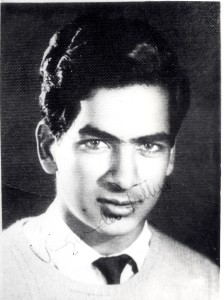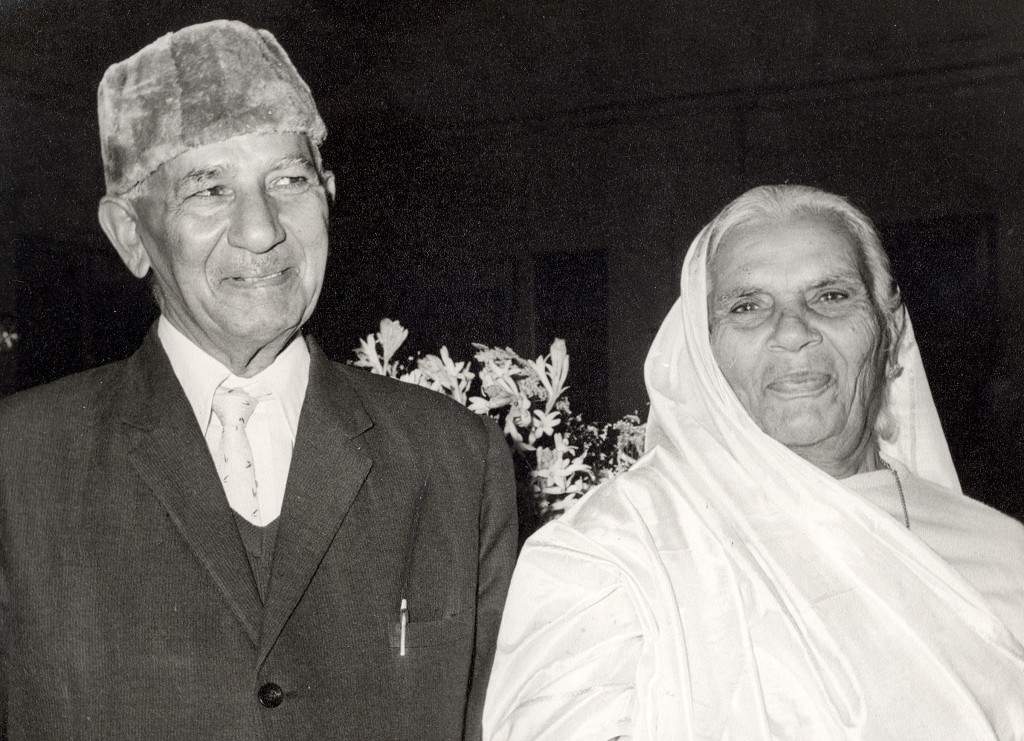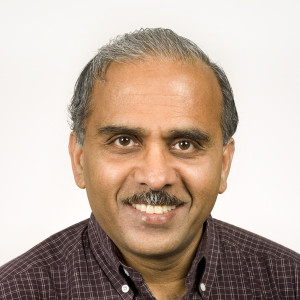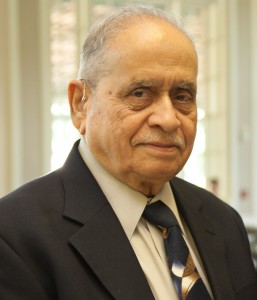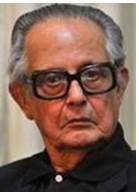Archive for category April 2015
Hillary Clinton’s Challenges in Her Presidential Ambitions
Posted by admin in April 2015 on April 12, 2015
By Kollengode S. Venkataraman
e-mail:Â Â ThePatrika@aol.com
Hillary Clinton has an unmatched, long record in public life — as the wife of a small-state two-term governor of Arkansas, the wife a popular two-term US president, a two-term US senator of New York State, and as the powerful Secretary of State and President Obama’s foreign policy spokesperson and negotiator on the global stage.
She was also in the grueling and vicious primaries during 2006-08 seeking the Democratic nomination, which she had to concede to Obama.
In the White House as President Clinton’s wife, she took the unusual step for a First Lady in spearheading Clinton’s healthcare initiative on the Congressional hearings, which went nowhere in the US Congress with GOP majority in both chambers. Over the years, she has created for herself a large base of political support, advisors, and donors within the party.
While Mrs. Clinton is ambitious, her track record is long, but contentious. She is now mulling over whether to seek the Democratic nomination again. She is guaranteed to get the Democratic nomination with no primary challenger with gravitas yet in the horizon. However, in the rough-and-tumble of American presidential politics, primaries help candidates to hone their rhetorical skills and burnish their images to prepare themselves for the fall campaign. So, not having serious primary opponents may not be a blessing either for Mrs. Clinton or the Democratic Party.
Also, the same characteristics of Mrs. Clinton that endear her to liberal Democrats also arouse passion against her among Republicans. So, Clinton may be vulnerable if she can not rally the entire Democratic Party around her and then some independent voters as well.
Republicans, now controlling the US Congress, will continue to do so for the next several election cycles. And with President Obama leaving office after his two terms, Republicans will work hard and be energized to win the White House to have complete control of the government.
So, Mrs. Clinton, if she should seek and get the party’s nomination, will have an uphill task ahead in the 2016 fall elections.   The End.
Iran’s Nuclear Ambitions
Posted by admin in April 2015 on April 12, 2015
By Kollengode S. Venkataraman
e-mail:Â Â ThePatrika@aol.com
The US dropped atomic bombs over Japan in 1944 and ended WW- II with stunning effect, the only time thus far that nuclear weapons were used in warfare. So, nuclear technology for military applications is at least 70 years old. With the awesome power of this weapon seen in such dramatic display, it was natural that many others — UK, France, Russia, China, India, Pakistan, North Korea, and Israel, besides the US — would later acquire nuclear weapons, claiming them as deterrents.
Consider the other developments that have enveloped the word since 1944, without which our life today will be unthinkable:
- PCs, the Internet, and digital technology radicalizing the way we store, transmit and access texts, sounds, and images, with the communication technology impinging on every facet of our lives;
- Organ transplants, MRIs and CT scans, robot-assisted surgeries, metal/plastic replacements for joints, artificial insemination and surrogate pregnancies, stem cell-based cures for diseases;
- The ubiquitous cell phone, even in remote places; and
- Star Wars weapons; and missiles fired from drones flying over Asian and African skies by technicians sitting in Arizona or Utah playing with joysticks and keyboards to release the guided missiles, and then going for their coffee nonchalantly. It is surreal and eerie.
These examples are only to stress that nuclear technology is pretty primitive today.
It is another matter that the stunning developments in communication technology did not lead to what was prophesied — improved understanding among peoples and countries. This is not surprising. After all, the human instinct to predatorily control and subjugate others is so natural that man from the Stone Age to modern times has always used developments in S&T to extend his control over others — through fair means where and when possible; and through foul means where necessary and convenient, and when he can get away with it. There is no altruism here.
Take India and China. They belonged to the wretched “Third Word†four or five decades ago. Now, having become “Emerging Economiesâ€Â — China is now fully “emerged†— they no longer speak on how powerful nation-states exploit weaker states. Now they have joined the club.
India, in the Third World basket in the Cold War era, was the leader of the Non-Aligned Movement. Now, it has nuclear weapons and missiles, its economy is strong, its social indicators are on the upswing, it exports weapons to other countries, and wants to be a regional power. Understandably, the Non-Alignment is not India’s priority today, and it rarely talks about it even for public consumption.
In the days of the Wild West in the US, the guy with the fastest hand in drawing the gun — irrespective of whether he was good or bad — was feared by the helpless locals and earned the grudging respect of the local sheriffs, bankers, big merchants, petty shop keepers, and also from fellow gunslingers. Analogously, in the international arena, nation-states of all ideologies with the most lethal weapons – nuclear or biological and the delivery systems to accurately hit their targets thousands of miles away — are feared by weaker countries; they also get the grudging respect of the UN and the other powerful countries, including their ideological opponents. With these weapons and delivery systems, you join the unrecognized, yet prestigious “Clubs.†And you become relevant in all negotiations to discuss non-proliferation.
This background is necessary to look at Iran’s nuclear program. Iran has a civilizational continuum that goes back a few millennia. It had one of the oldest empires, the Achaemenid Empire, founded by Cyrus the Great, in the 6th century before the Common Era. Even though it is 98% Muslim, it has its own new year Nowruz, starting with the Spring Equinox in March, with its origins going back to the Achaemenid empire. Its population is ~ 92% Shia, with influence in Central Asia and the Middle East. Iran fears that it is living in a hostile neighborhood with Israel and the Sunni Arab sheikhs living under the American military umbrella trying to destabilize it through covert and overt actions. Besides, Iran — and many other non-nuclear countries, for that matter — see the industrialized nations’ stand on its nuclear program hypocritical.
furthermore, in its neighborhood, India, Pakistan, Israel, and Russia have nuclear weapons. As Iran sees it, after all, the Isais* have it, the Yahudis* have it, the Hindus* have it, the Mulhads* have it… … worse still, even the Sunnis* have it. Only we, the Shias, don’t have it. So, why should we not have it?
Does anyone today seriously believe that Iran — or any other country with serious commitment — can be stopped from developing the primitive 70-plus-year-old technology for making nuclear weapons? That is how India, Israel, Pakistan and North Korea got it. At best, the outside world can only delay it. Using strong-arm tactics on this point will only make Iran to stiffen its spine tio become more committed and determined to pursue the technology. Remember Zulfikar Ali Bhutto declaring, “We (Pakistanis) will eat grass, even go hungry, but we will get … our own [atom bomb)]!â€Â And they did get not only the nuclear technology, but also the missle system to deliver them.
* Isais: Christians (US, UK, and France); Yahudis: Jews (Israel); Hindus: (Indians); Mulhads: Atheists (Chinese and Russians); Sunnis: Pakistanis   The End
Facing headwinds, The Silk Screen seeks your help
Posted by admin in April 2015 on April 12, 2015
By Kollengode S Venkataraman
e-mail:Â Â ThePatrika@aol.com
When you think of international film festivals, you think of glamour, high-end lifestyle (much of it contrived) mixed with creativity, and a decent blend of genuine and faux intellectualism. Men in intentionally but fashionably unkempt accoutrements and women in expensive clothes and jewelry. And you also think of hot-spot venues — the French and Spanish Riviera, Palm Springs, Tokyo, Miami, Boston… …
These annual jamborees are too many in fact — over 80 in Asia (India, China, Japan, Taiwan, Korea); over 120 in Europe; over 200 in North America; and 26 in Latin America and the Caribbean.
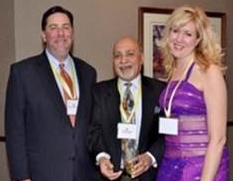
L to R: Pittsburgh Mayor Bill Peduto, Harish Saluja and Katie Jones of Silk Screen Festival in the last year gala.
So, it takes courage to even think of starting a film festival in Pittsburgh, hardly a tourist destination even within the Northeast or the Mid-Atlantic states. But that is exactly what Harish Saluja did nine years ago when he organized the first Silk Screen film festival with a focus on films made in Asia.
One can be courageous — or foolhardy — to embark on something daring in uncharted territory. But courage alone does not sustain you there. You need another trait — endurance and perseverance — to make your idea work over the long haul. That Silk Screen-2015 is entering its 10th year is a testimony not only to Harish’s endurance but also to his passion and commitment to his cause.
Here is more evidence of his endurance: for over forty years, Harish and his long-time friend Dr. Vijay Bahl, have been hosting the Sunday Music of India program on 90.5 FM, spending their personal money to get recordings of songs from India.
All through these nine years, he has received support from individual benefactors — Ashok Trivedi, Vijay Bahl, Atul Bansal, Neeta and D. Raja, Nitin Badjatia, Sushil Jain, Seema Batra, Krishna Pendyala, Rashmi & Ravi Koka, Dolly & Juginder Luthra, and Saroj Bahl — and philanthropic organizations who wanted to project into new orbits the picturesque Pittsburgh metro area with its meandering rivers & roads, bridges & tunnels, rolling hills & valleys.
With this asset, and the cinematographic skills available right here, as well as lower production costs, more and more films are being shot in Pittsburgh.
But Harish’s Silk Screen festival is lately facing strong headwinds in raising funds for an unexpected, but entirely understandable reason — the well-earned and well-publicized material success of the Asian-American Diaspora. These are people of Indian, Chinese, Philippine, and Japanese origins and Asians in the US.
Harish’s benefactors — both individuals and foundations — are telling him that they would continue to support the Silk Screen festival, but with this caveat: their support will be only as matching funds.
They are telling him in not so many words, “Asians here have become very successful in their careers, professions and businesses, and resourceful in their lives. So, you raise funds from within your prosperous Asian communities, and we will give you matching grants.â€
This makes sense. With wealth comes societal obligations to improve the quality of life. And the arts definitely add to the quality of life.
This is where Harish needs your support. Many of you sould have received his letter in December 2014 appealing for help. Here are the excerpts:
The annual Silk Screen Festival has become a much-anticipated event next year [with] many award-winning films [and] several filmmakers/actors. Silk Screen-2015 will be held July 10-19.
Silk Screen is an Asian Arts and Culture organization whose aim is to build bridges across various ethnicities… In addition to the film festival, there are several documentary series in schools and dances and music performances in various venues including the Children’s Museum. [Editor’s Note: The Asian American Jazz Group Silk Sound recently produced its first CD.]
The support from several Foundations now comes as matching funding. So we must raise considerable amounts from the community to be matched. We hope you will include us in your annual holiday giving this year. Any amount is welcome.
Donations are tax deductible since Silk Screen is a non-profit, charitable organization. So, make your tax-deductible checks to Silk Screen and mail to:
Silk Screen
Attention: Harish Saluja
2000 Smallman Street Suite 203 B
Pittsburgh, PA 15222
You can also contact Harish at hsaluja@silkscreenfestival.org or at 724.969.2565. Their website is: Silkscreenfestival.org.    The End
Personally Speaking: Dreams Don’t Die
Posted by admin in April 2015 on April 12, 2015
By Juginder Luthra, Weirton, WV
e-mail:Â dolgin1968@gmail.com
Editor’s Note: Very often people realize their unfulfilled dreams — unfulfilled on account of the combination of several factors beyond their control — through the accomplishments of their children. No wonder in Sanskrit one expression for son is Atmaja, literally meaning “born out of oneself.†So, people see extensions of themselves in their children. Often, parents recount how they realized their dreams through their children. However, when a son recounts how he has been living his father’s dreams, the impact is very different. Here are Juginder Luthra’s recollections on his becoming a physician. He is close to retirement after practicing ophthalmology in Weirton, WV.
There was a flurry of activity all over the house. “Is the suitcase ready, did you pack enough mango pickle and praanthe with cooked dry potatoes placed between them? Are your shoes polished, do you have enough money for the journey? Do you have Dr. Chitkara’s (Pitaji’s cousin) address where you will be staying for the first 3 or 4 days?â€
The last one was planned to avoid the notorious, scary ritual of ragging, called hazing in the US, that every new student received from seniors.
“Make sure your shoes match; one black and one brown will look really funny. Don’t stick your head out of the moving train, you will get coal particles fly into your eye. Above all, no more mischief; you are a big boy now.â€
Questions and advice were coming from every corner and everybody. Mataji (as my siblings and I called our mother), with tears in her eyes and sniffling, said haltingly with a raspy voice, “Make sure you eat properly; I will not be there running after you with butter-soaked praanthe and your favorite bhindi and karele.†She kissed my forehead. Our tears mingled.
What was the fuss and occasion for all this hoopla in September, 1961 at house number 2, Model Town, Panipat, 50 miles north of New Delhi?
I was on my way out of the house at the age of 17, alone, and plunging into the large strange world. I grew up with the luxury of being sheltered by my mother, brothers, sisters, and Dadaji (paternal grandfather). And my father, who was mostly physically absent but in spirit always around.
After the Partition of India in 1947 and our arrival in India as refugees from what now had become Pakistan, the responsibility of supporting the large family was on Pitaji (Father). Money earned from the newly learned trade of making bricks was never enough. First, the eldest son, Suraj, followed next by Prem and then Virinder got jobs and supplemented his meager income. All of this combined money was barely enough to cover the basic needs of shelter and food. Mr. Kundan Lal Luthra, my father, recognized from his own personal experience that education was as essential as food. Educating his children was the main goal of his life.
Eleven boondi laddoos had been distributed as gifts to all the neighbors, appropriate donations had been made to the needy woman, Brahmni, who visited us weekly to receive money and food for her recently uprooted family. Ganesh, the Remover of Obstacles, had been invoked with indecipherable mantras. Proper blessings had been received from the family Gurus — Swami Satya Nandji and Shakuntla Behanji.
It, indeed, was a big occasion for the family and above all for Pitaji. I was the first child going to medical college, and hopefully becoming the first doctor in our family. The six older siblings had become engineers, businessman, and teachers. The one younger than me, the last one of the eight siblings, had declared his intentions of becoming an engineer.
I also had wanted to become an engineer — because I hated blood! In hindsight, what a foolish reason it was; but at that age, it was a major reason for me to join 2-year pre-engineering courses after high school. I had already attended pre-engineering classes for three months in 1959 at Government College, Rupar, Punjab.
A two weeks All India tour for me arranged through the college, gave Pitaji the window of opportunity to change the course of my life. In my absence, he went to the college, cancelled my physics and math classes and entered my name into botany and zoology. He also arranged evening tuition and extra classes to make up for lost time.
He was happy that I did not object and quietly followed the path carved out by him. I have been, forever, thankful for his foresight. We learned later that there was a whole different dimension to this action. It was a moment of fulfillment of a long, hibernating dream for Pitaji, the architect of education for the whole family.
Kundan Lal, my father, was one of two sons of Lala Gokul Chand. In the early 1900s Lalaji had been gifted ten acres of land in Khanewal (near Multan in Pakistan) by his British officer. Kundan’s younger brother, Karam Chand, was meant to take over the farming. Kundan loved to help people. What better way to serve than to become a doctor, was his thinking. With this goal in mind, Kundan studied pre-medical courses in Dayanand College, Lahore. He completed the prerequisite courses, and earned more marks than required to ensure admission in the prestigious Medical College, Lahore.
Much to Kundan’s disappointment, a Muslim boy with lesser marks, was given his spot due to the quota system then in practice. Not one to be defeated and give up, Kundan continued his studies, completing B.Sc. to definitely ensure admission to the medical college in the following year. His decisions and academic performance were on track.
But no one can foresee or predict the Hand of Destiny. What is not meant to be will not be, despite all our effort. You can come up with all descriptors — defeatism, a rational defense mechanism of acceptance, ingrained deep faith in Destiny, or Will of God as has been the Hindu way of looking at life’s transitions.
Those days, infectious diseases were common causes of death in all age groups. Kundan’s younger brother, Karam, fell victim to one such disease and died as a result. Their mother died shortly thereafter. Lalaji, Kundan’s dad, summoned Kundan back from Lahore to Khanewal to look after the land. His pleas to let him continue the education fell on deaf ears. One could cry and make a scene, but in those days one dare not refuse the dictates of the family elders. Such was the culture of that era (circa 1925).
Kundan Lal, the budding doctor, overnight became doctor of the crops. And what a farmer he became! Farmers from all around Khanewal sought his advice on all aspects of farming.
However, the suppressed, dormant and hibernating seed of becoming a doctor never died in him. One day it had to sprout.
He must have seen something in me akin to himself and saw a doctor in me serving humanity.
That is how my pre-engineering studies became pre-medical. After getting sufficient grades, I got selected into Medical College, Amritsar, nearly 250 miles from Panipat and only 20 miles away from Lahore, Pakistan.
I was finally ready to embark on the daunting, lonely journey to Amritsar on a newly started train, the Flying Express. After the flurry of activity at home, good byes, tight hugs and tears, Pitaji escorted me to the train station. The train, as usual, was running late.
He would not talk much, but looked at me with his usual style of tilted head with a slanted gaze, a tear building up in the corner of his eyes. He carefully wiped it by the same motion as if he was straightening his hair, hoping the train would be a little more delayed.
A loud whistle, a down green signal, and the plume of smoke from the steam engine fueled by coal far away, broke Pitaji’s trance. Overhead speakers announced the arrival of the train that would take his son away to finally fulfill Kundan Lal’s long cherished dream. The tears he held back could not be subdued any longer; a mixture of joy and sorrow moistened my cheeks and collar as he gave me a tight reassuring hug.
The train rolled out gently. His blessings to serve people, and become as good a doctor as he had dreamt to be, kept following me through his loving gaze, gradually fading smile and waving of his hands. Â Â Â Â The End
Dekho Hamara Amreeki Desh !
Posted by admin in April 2015 on April 12, 2015
By K S Venkataraman
e-mail:Â ThePatrika@aol.comÂ
We’ve occasionally published stories under Dekho Hamara Hindustan highlighting how uninformed some of the Indian elected officials can be. The rights of elected officials to publicly display how dumb they are have no geographic boundaries. Here is an Amreeki version.
In February 2015, the Idaho legislature held a hearing on a bill that proposed to ban doctors from prescribing abortion-inducing medications through telemedicine. Idaho’s state representative Rep. Vito Barbieri (GOP) (see the picture) was in the committee hearing of people both supporting and opposing the bill.
Dr. Julie Madsen, a physician who provides various telemedicine services in Idaho, was opposing the bill that will restrict doctors from prescribing medications to terminate pregnancies such as the “Morning-After Pill.â€
The legislators were asking Dr. Madsen about colonoscopy to see if it could be done noninvasively. Here are the exchanges in the hearing:
 Rep: Barbieri: You mentioned the risk of colonoscopy. Can that be done by drugs?
  Dr. Madsen: Mr. Chairman, Rep. Barbieri, it cannot be done by drugs. It can, however, be done remotely, where you swallow a pill, and this pill has a little camera, and it makes its way through your intestines, and those images are uploaded to a doctor who’s often thousands of miles away, who then interprets that.
  Rep. Barbieri: Follow up, Mr. Chairman.
  Chair:  Rep. Barbieri.
  Rep. Barbieri: Can this same procedure then be done in a pregnancy? Swallowing a camera and helping the doctor determine what the situation is, with the … …
  Dr. Madsen:  Mr. Chairman and Representative, it cannot be done in pregnancy simply because when you swallow a pill, it would not end up in the vagina.
[laughter]
  Rep. Barbieri: Fascinating! That certainly makes sense, doctor.
The laughter in the room at Dr. Madson’s response to Rep Barbieri’s question was not a polite one. It was derisive because of the Republican state representative’s ignorance on the basic anatomy of the human body.    —   The End
…   — By K S Venkataraman
Excellence in Teaching and Research — Prof. Vijayakumar Bhagavatula
Posted by admin in April 2015 on April 12, 2015
By Prof. Pandu R. Tadikamalla
Katz School of Business, University of Pittsburgh, PA 15260
e-mail:Â Â pandu@katz.pitt.edu
Note:  Pandu Tadikamalla is a professor of Business Analytics and Operations at the Katz School of Business. He came to the US in 1970 and earned his MS and PhD from The Univerisity of Iowa. He lives with his wife Rama in Squirrell Hill.
Professor Vijaya Kumar (popularly known as Professor Kumar to his students and peers) received the U.A. and Helen Whitaker professorship of Electrical and Computer Engineering at the Carnegie Mellon University on November 25, 2014.
The professorship, established in 1973 by U.A. Whitaker (E’29) and Helen Whitaker, recognizes a faculty member for important, cutting-edge research in Electrical and Computer Engineering.
After receiving his PhD in electrical engineering from Carnegie Mellon in 1980, Vijaya Kumar joined the faculty at the university in 1982. His B.Tech (1977) and M. Tech (1980) were in electrical engineering from IIT Kanpur, India. He is currently the associate dean for Graduate and Faculty Affairs for the College of Engineering. He has also served as interim dean for the college and as acting department head of Electrical and Computer Engineering.
Prof. Kumar, an excellent teacher and researcher, leads many important studies at Carnegie Mellon. He has carried out important work in matching live biometric signatures with stored templates through correlation. Kumar and his students are also developing several spatial frequency-domain methods to perform these correlations in the presence of significant appearance variability such as illumination changes, expression differences, and others in the biometric signatures. These correlation filters have performed well in competitions such as the Face Recognition Grand Challenge (FRGC) and Iris Challenge Evaluation (ICE) conducted by the U.S. National Institute of Standards and Technology (NIST).
Dr. Kumar has published nearly 200 research papers in journals; and has written eight text books and supervised over fifty PhD students. Countless number of students have earned their master’s degree under him. He is also a Fellow in four professional societies related to his field.
In the investiture ceremony for the chaired professorship, Dean James Garrett of the CMU College of Engineering, Dr. Abjiji Mahalanobis, a senior Fellow at Lockheed Martin, and Dr. Pradeep Khosla, (former dean of the CMU College of engineering and currently the Chancellor of University of California, San Diego) also spoke. One common theme in their speeches was Kumar’s passion for teaching and research. In addition to his scholarship, he is also known for his collegiality and willingness to help his colleagues and students at all times without any reservation.
Vijaya Kumar comes from a family of accomplished professionals. His three sons are all engineers, graduated from Carnegie Mellon with masters and PhD degrees. His wife Latha is the operations manager at the S.V. Temple in Penn Hills. Latha has coordinated several Telugu cultural activities including teaching Telugu at the S.V. Temple.
Despite all his accomplishments and professional recognition he has received, Dr. Kumar is very modest about his track record.
Please join me in congratulating Prof. Vijaya Kumar for his academic excellence and dedication to research and teaching. Â Â The End
Continuing Care at Home (CCAH) Programs: An alternative to Long Term Care insurance
Posted by admin in April 2015 on April 12, 2015
Balwant N. Dixit, Ph. D.
Professor of Pharmacology (Emeritus)
608 Ravencrest Road, Pittsburgh, PAÂ 15215 USA
Phone: Â (412) 963-8023 Â Â Â Â e-mail:Â Â bdixit@pitt.edu
In the January 2015 issue of Pittsburgh Patrika I wrote about an unexpected medical emergency my wife, Vidya faced during our short visit to Washington DC. After her return to Pittsburgh by ambulance, Longwood at Home (LaH), a Continuing Care at Home (CCAH) Program, provided Vidya excellent help when it was most needed. LaH is located in the Pittsburgh area providing services to members that reside in the five county areas in Western Pennsylvania (i.e. Allegheny, Beaver, Butler, Washington and Westmoreland). Vidya and I became members of LaH three years ago and have been very satisfied with the services its staff has provided to us. I hope that readers of Pittsburgh Patrika will find the following information about CCAH programs useful.
Continuing Care at Home (CCAH) Programs and their Locations: CCAH programs, a unique alternative to Long Term Care Insurance (LTCI) are not very common but are expected to expand in the future as “baby boomers†retire. This mode of service delivery is ideal for the middle-income seniors who choose not to move into one of the traditional Continuing Care Retirement Communities (CCRC) which are usually quite costly, still receiving the full continuum of care similar to a CCRC. At present, CCAH programs are available in six states; New Jersey, Pennsylvania, Ohio, Tennessee, Maryland and Delaware. Most offer portability within the USA after being a member for a year or more. A CCAH program in California (CA) is in its final stages of legislative approval. Details about LaH and Friends Life Care (FLC), a CCAH program located near Philadelphia, PA, provides similar services to the residents of Eastern Pennsylvania and Delaware (DE).
(1) Longwood at Home: LaH (http://www.longwoodathome.org), is licensed by the Pennsylvania Department of Insurance and is a unique alternative to Long Term Care insurance (LTCI). LaH is affiliated with Presbyterian SeniorCare, an accredited Aging Services Network (http://www.srcare.org/).
The following are important features of Longwood at Home: (i) Service & Care Options: One-time enrollment fee and low monthly fee provides a member access to a continuum of services right in your home. A portion of the fees (usually around 85%) is Federal Tax deductible since it is attributable toward medical expenses. LaH membership guarantees the very best private duty and facility- based care as your needs change. (ii) Care Coordination & Care Continuum: As a member of LaH, a personal Care Coordinator is assigned to you, and can arrange any service you might require. In the event of an emergency, Care Coordination staff is available 24 hours a day, seven days a week. As your needs change, LaH can coordinate a variety of care options from companion/homemaker services, to licensed home healthcare and home care aide services and live-in assistance. (iii) Home Inspection: During the first year of membership and every other year thereafter, LaH provides a licensed therapist to do a safety and functional inspection of your home and make modification recommendations. (iv) Transportation: LaH provides transportation both ways for medically necessary outpatient procedures and for hospitalizations. A care giver always accompanies a member during such appointments. LaH can also assist with transportation coordination for other needs, such as routine doctor visits, however members are responsible for the costs for such visits. (v) Coverage Options: LaH offers six levels of coverage for healthy adults age 60 and over. Each offers the opportunity to remain independent in one’s home, services of a professional Care Coordinator, with access to a lifetime of excellent, affordable care and services as your needs change. (vi) Insurance: Members are required to maintain Medicare A & B insurance plus Medicare Supplemental Insurance (a Medigap plan) or a Medicare Advantage Plan, both being offered by private insurance carriers. (vii) Residential requirements: One must be a resident of the five county area of Western Pennsylvania on the day he or she decides to enroll. (viii) Portability: Arrangements can be made for providing similar services at no extra cost, for a member who has completed at least one year with LaH, while travelling or residing outside the service area of the five counties, but within the USA, (ix) LaH Membership for those who have Long Term Care Insurance (LTCI): A person with LTCI can become a member of LaH. If the policy holder meets the criteria for LTCI coverage (i.e. inability to perform two activities of daily living for 90 days or severe cognitive impairment) his LTCI policy can be used to pay the monthly premium for LaH. LaH does what the LTCI carrier will not do, in that LaH offers personal care coordination and immediate response – any change in health or functional status or inability to perform one activity of daily living – no waiting period. However, if one stops paying premiums for LTCI, coverage will cease.
(2) Friends Life Care (FLC): Founded in 1985, FLC is a nonprofit Quaker organization serving eastern Pennsylvania and Delaware ((http://friendslifecare.site-ym.com). FLC is regulated by the Pennsylvania Department of Insurance as a Continuing Care Retirement Community (CCRC), and like LaH provides professional care management, home care and related personal care services. Headquartered near Philadelphia, PA, FLC operates in eastern Pennsylvania and Delaware. Residents of both states qualify for membership. The plan is portable for members who relocate within the PA or DE or the USA—either to another state or region, or into another living arrangement, including downsizing to an apartment or a fee-for-service retirement community. For members who relocate, and for those who like to travel, FLC arranges care through affiliated organizations that meet their rigid standards of excellence. FLC extends membership to adults aged 40 to 81 who are in reasonably good health and living independently but not currently in a facility.
Acknowledgment: Advice given by Grace Smith of LaH, Sudhir Manohar and Girish Godbole is gratefully acknowledged. Â Â End
“Asianization†of America is Real!
Posted by admin in April 2015 on April 12, 2015
By Kollengode S Venkataraman
e-mail: Â ThePatrika@aol.com
 Sometime back, I wrote an article titled Asianization of America that my reviewer did not like on the first go. After a long discussion, she grudgingly said, “OK, may be you can run this.â€
My point was that in the US too, much like in Asia (India, China), graduates in humanities, social sciences, literature, and performing arts are getting fewer well-paying jobs offering health insurance. So, everybody was chasing degrees in engineering, business, finance…
And then came this article by Gary Gutting, a professor of philosophy at the University of Notre Dame, and editor of Notre Dame Philosophical Reviews, titled “The Real Humanities Crisis†in the New York Times of Dec 1, 2013. See here: www.tinyurl.com/humanitiescrisis. These excerpts tell the crisis in the US is identical to what has been happening in India for the last 50 years:
“Humanities majors on average start earning $31,000 per year and move to an average of $50,000 in their middle years. (The figures for writers and performing artists are much lower.) By contrast, business majors start with salaries 26% higher than humanities majors and move to salaries 51% higher.
“… … Even highly gifted and relatively successful writers, artists and musicians generally are not able earn a living from their talents. The very few who become superstars are very well rewarded. But almost all the others — poets, novelists, actors, singers, artists — must either have a partner whose income supports them or a ‘day job’ to pay the bills. Even writers who are regularly published by major houses or win major prizes cannot always live on their earnings.â€
This has been the experience of Indian performing artists and writers both here and in India for over 60 years. Â In India – Â and for that matter, even in the US — Â how many of the Indian vocalists, dancers, and instrumentalists and writers can sustain their middle-class life style if they are going to depend only on the earnings through their skills as artistes and writers? Almost NONE. Â Most of them have full-time jobs or have professional spouses to give them the middle-class life style. Â This is a simple fact.
Prof. Gutting continues:
“With tenured professorship at a university, or if you play regularly in a major symphony orchestra or write mega best sellers, you can earn an excellent living doing what you love. Short of that, you must pursue your passion on the side.” This is what many well-known Indian writers have been doing for the last several decades.
Gutting Continues: “Teaching should be an obvious solution for many humanities majors. But well-paying tenure-track jobs are disappearing… half of college teachers now are part-time adjuncts… who fail to make a living wage. ”
This only confirms that as a consequence of globalization many social problems of the industrialized West increasingly resemble those in India, China, Taiwan.    The End.
Rare Candor in Diplomatese
Posted by admin in April 2015 on April 12, 2015
By Kollengode S Venkataraman
In diplomatic exchanges, it is all about nuances, parsings, minutiae, contextualizing, saying something and meaning/implying something very different, and conveying decisions by silence and pauses, or not stating anything at all on specific topics. But the following two examples are in stark contrast making candor a virtue, even when dripping in sarcasm:
Greece, a member of the EU, is close to economic collapse in the wake of long economic mismanagement of the country — rampant tax evasion, crony capitalism, nepotism, nexus between politicians and businesses… After the recent elections in Greece, the new leftist government’s finance minister met with Germany’s financial officials for help. Germany is the EU’s economic behemoth demanding fiscal discipline among the EU’s members. The early meetings between the two went nowhere.
In meeting reporters, Germany’s staid finance minister was trying to be diplomatic and told reporters, “We agreed to disagree.†The Greek finance minister standing by quickly offered this impolite retort: “We didn’t agree to disagree. We agreed to enter into a discussion for a joint solution for all European partners.†You figure this out.
After the Russian army entered into Crimea, a region populated by ethnic Russians in Ukraine, in early 2014, the West imposed sanctions on Russian businessmen and blacklisted many Russian businesses close to Putin. The affected Russians mocked the sanctions, wearing them as a badge of honor.
These sanctions also rankled Moscow’s politicians. Russia’s deputy Foreign Minister Sergei Ryabkov told this gem to the Interfax news agency regarding the Russian military actions in Crimea:
“What can one advise our U.S. colleagues to do? [Go and] spend more time in the open, practice yoga… …[and] maybe watch some comedy sketch shows on TV. This would be better than winding oneself up and winding up others, … The ship has already sailed … Tantrums, weeping and hysteria won’t help.â€
This quote will enter into the annals of famous quotes in international relations. Â End
Rita Ganguly’s Enchanting House Concert
Posted by admin in April 2015 on April 12, 2015
By Seema Chaubey, Irwin, PA
e-mail: Â seemachaubey@hotmail.com
Note: Seema Chaubey is from Kolkata, India She learned Hindustani music from Ashim Mitra and the late Sachin Das Motilal in Kolkata. She is a music lover and resides in Irwin, PA with her family.
On November 15, 2014, Chhandayan, the Pittsburgh-based organization dedicated to Hindustani music, presented their third and last house concert of 2014 at Samar and Mala Saha’s home in Irwin, PA with nearly fifty people in the audience. The star of the evening was the notable vocalist Padma Sri Rita Ganguly (Rita-di for her admirers), accompanied by Pandit Samir Chatterji on the tabla and the young and talented Amir Khan on the sarangi. Pittsburgh’s Ayan Sinha provided harmonium support and Ganguly’s daughter Meghna Kothari was on the tanpura and provided vocal support. The picture below shows the ensemble of the artistes.
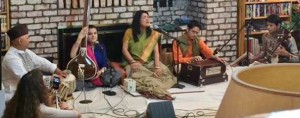 Before Rita took the stage, the musical program began with Amie Maciszewski’s short and sweet sitar recital. She is from Dallas, Texas and was trained by sitarist Suresh Misra and Grammy winner Ustad Asish Khan. She began with raga Puriya Dhaneshwari, a twilight melody and unfolded the raga in the traditional manner of three movements – a leisurely Alap, followed by the slow Vilambit Gat, ending in a climax in Drut Gat. She ended her recital with a shorter piece in Misra Todi. Pittsburgh’s Asish Sinha provided percussion support on the tabla, ably responding to the sitarist’s Drut Laya Bols with his Paltas.
Before Rita took the stage, the musical program began with Amie Maciszewski’s short and sweet sitar recital. She is from Dallas, Texas and was trained by sitarist Suresh Misra and Grammy winner Ustad Asish Khan. She began with raga Puriya Dhaneshwari, a twilight melody and unfolded the raga in the traditional manner of three movements – a leisurely Alap, followed by the slow Vilambit Gat, ending in a climax in Drut Gat. She ended her recital with a shorter piece in Misra Todi. Pittsburgh’s Asish Sinha provided percussion support on the tabla, ably responding to the sitarist’s Drut Laya Bols with his Paltas.
Ganguly took the stage starting with Mere Shyam Na Aye, a bol Banao Alap in Raga Jhinjhinoti and Jat Tal, a short piece on the yearning of one’s soul for the spiritual love of Shyam. Her next number Hamri Atariyape Aayo Sanwaraia was a traditional Thumri in Sindhu Bhairav, a musical composition of her guru Begum Akhtar using Gulzar’s lyrics. Ganguly’s deep, husky and richly-timbered voice and the momentary split in her voice, called “Patti,†reminded the older members of the audience of Begum Akhtar.
Her next piece Koyelia Mat Kar Pukar, a familiar Dadra, immortalized by Begum Akhtar, made the audience hum and sway to the melody. Next was Mere Humnafas Mere Humnawa, a Shakel Badayuni’s ghazal in raga Darbari, which translates to “It may or may not work, but you do not refrain from beseeching the object of your love, who has showed signs of wavering, not to betray you.â€Â Ghazals bring out the finer nuances of true love, and the Sufi system of seeing the Creator as one’s lover elevates the romance in the song to a higher level. Although many of us were not well-acquainted with Urdu, the performer’s explanation and the mesmerizing rendition took us to that higher plane.
Rita next moved into a new genre of her own called Jibanmukhi, similar to the Urdu Nazm. She presented three poems of Bengali poets Shakti Chattopadhyaya and Shankha Ghosh and interpreting them with music in the tradition of the Nazm.
Rita continued with a couple more ghazals before concluding her recital with the ever-familiar and much-requested Aye Mohabbat Tere Anjaam Pe Rona Aya, a Shakeel Badayuni’s Ghazal in Bhairavi.
All through Ganguly’s recital, Samir-ji’s tabla was telling a story of its own, on how tabla can open up the flood gate of emotions hidden in Hindustani semi-classical compositions.
The young and very talented Amir Khan’s accompaniment on sarangi was haunting and melodious, keeping in tune with the songs of Rita Ganguly.
Samar Saha, the host, welcomed the artists and offered the concluding remarks before serving a delicious buffet-style dinner. Â End
Summerset at Frick Park: Ideal for Families
Posted by admin in April 2015 on April 12, 2015
By Melissa Reich
Home Sales Expert, Summerset at Frick Park
1435 Parkview Boulevard, Pittsburgh, PA 15217
Phone: Â (412) 215-8056
 Many Indian families choose Summerset at Frick Park because of its proximity to cultural and religious attractions, as well as its convenience to the Waterfront, downtown, and Oakland. A short drive from many places of worship for Indian-Americans in Monroeville, residents have a religious community nearby. Additionally, the neighborhood is close to many Indian grocery stores and restaurants in Monroeville and Oakland as well as the Strip District markets.
Many Indian families choose Summerset at Frick Park because of its proximity to cultural and religious attractions, as well as its convenience to the Waterfront, downtown, and Oakland. A short drive from many places of worship for Indian-Americans in Monroeville, residents have a religious community nearby. Additionally, the neighborhood is close to many Indian grocery stores and restaurants in Monroeville and Oakland as well as the Strip District markets.
The convenience of city living paired with the neighborhood’s park-like atmosphere and access to Frick Park attract many diverse groups to the neighborhood. International residents move there because of its location near Pittsburgh’s medical, technology, and entertainment hubs. However, it is also home to many longtime Pittsburghers moving back into the city who are interested in customizing a new home.
Summerset at Frick Park families can ensure an excellent education for their children through access to the best private and public schools in Pittsburgh. Within walking distance of award-winning Allderdice High School, teens also have the option of attending the Pittsburgh Creative and Performing Arts School (CAPA), or one of the many private high schools nearby. Allderdice was ranked #9 in top SAT scores for 2014 in the Pittsburgh region, with CAPA just behind it at #10. Ellis and Shady Side Academy boast a diverse student body, small class sizes, and committed, experienced teachers. Music teachers living in Summerset at Frick Park, as well as nearby gifted afterschool programs at Pittsburgh’s universities, allow unique opportunities for enriching children’s education.
For higher education and medical needs, various universities and medical centers are nearby. The University of Pittsburgh, Carnegie Mellon University, Duquesne University, Point Park University, Carlow College, and Chatham University are all within 15 minutes of Summerset at Frick Park, so the community’s professors, medical professionals, and business leaders all enjoy a quick commute to work every day.
With a variety of new home construction options, Summerset at Frick Park has something for everyone. Facing east and south, the Schneider Park and Parkview townhomes range from 2,110 to 2,860 square feet, featuring open first floor plans that allow residents to create their own layout.
In addition to beautiful river views, townhomes include three bedrooms, covered front porches, attached garages, private outdoor spaces, and professional landscaping. End units offer a first floor master suite along with a third floor bonus loft and flexspace that are customizable to meet residents’ needs and perfect for extended family and guests. Buyers also have the option of adding an in-law suite, office, or gym.
In addition to its townhomes, Summerset at Frick Park also offers one-level condos called Manor Flats. Manor Flats offer 2,000 square feet of space with two bedrooms, a study, spacious walkup front porches, and covered side terraces. Also included are two parking spaces in the garage, an elevator, low maintenance exteriors, and professional landscaping.
Townhomes and manor flats are selling quickly, so please set up an appointment today by visiting www.SummersetatFrickPark.com or by calling home sales expert Melissa Reich at (412) 2158056. Â End
R. K. Laxman, the Irreverent Cartoonist
Posted by admin in April 2015 on February 1, 2015
By Kollengode S Venkataraman
e-mail: Â ThePatrika@aol.com
Recently, Rasipuram Krishnaswamy Laxman, the most celebrated cartoonist of India and the father of the dhoti-clad Common Man (archaic in today’s Indian metros) died at 94 in Pune after a well-deserving, well-earned, illustrious career spanning several decades.
Decades ago, Bombaywallahs — now Mumbaikars — and people in many other cities started their day only after reading Laxman’s “You Said It†cartoons in the Times of India. No one – whether politicians, the babus (bureaucrats), the poor, the rich, or the vainglorious  — escaped Laxman’s skewering, yet humorous wit focusing on human foibles, hypocrisy and inner contradictions.
He was keenly observant, very much in touch with the pulse of urban Indians, a common trait among social commentators whether columnists or cartoonists. His obituary ran in the English media worldwide. Tributes in India were torrential.
He was cremated in a private ceremony in Pune. The Maharashtra government gave him a ceremonial state funeral, a great honor for a cartoonist.
Lavishly praising the dead while overlooking their imperfections is an Asian trait. There is a popular and cynical saying in Tamil, settavan kannu sentaamarai, which translates in Hindi as murdaa kaa aankh gulaabi-kamal. In English, this would mean “The dead have golden eyes.† There is no popular English equivalent expression though, probably because there is no inhibition in critiquing the dead.
After Laxman’s death, his son Srinivas, a journalist with the Times of India, talked to his colleagues reminiscing his dad. One point he said is worthy of our attention (www.tinyurl.com/Laxman-Srinivas):
Srinivas said that the legendary cartoonist never conformed to rituals. “My father was accorded a simple funeral, without the rituals he himself never followed. I still remember my father’s reaction when he heard the news of his mother passing away . He had this habit of sitting with a drink at 9pm and listening to the radio. One day, he received a phone call from his brother informing him of his mother’s demise. She had passed away in Mysore. My father was immensely shaken with the news, but did not go to Mysore. He was very progressive; he did not observe rituals and was not a traditionalist,†said Srinivas.
Obviously, the other siblings of Laxman in Mysore who took care of his mother in her last days — a far more difficult responsibility if she was bed-ridden in her old age — also took care of her cremation.
Death rites are quite simple compared to providing hospice care for old people till they pass on. In India, even today, the options for hospice care are few even for its professional middle class, not to speak of India’s working poor. People taking care of old sick parents know this.
If Laxman had personal reasons for not going to his mother’s funeral, we need to respect and honor his private decision, and it would have been graceful for Srinivas to leave this biographical detail of his father private. But Srinivas went public on this, trying to correlate Laxman’s persona as a non-traditionalist and non-believer in rituals with he not going to his mother’s funeral rituals. This was unnecessary to say the least.
What has R. K. Laxman’s non-belief in rituals and traditions anything to do with Laxman not going to his mother’s funeral in Mysore? Honestly, is there any correlation between one’s non-belief in rituals and one not going to the funeral of one’s parents?
Laxman, decades ago, did not believe in the old rituals for his mother’s last rites. Such a radical departure from tradition decades ago would have jibed well if Laxman, given his star image, had instructed his son not to follow contemporary death rituals like public viewing, wreath-laying, etc. And the non-traditionalist Laxman’s son conformed to the “modern†traditions and rituals associated with a state funeral even as he was disdainful of “old†rituals.
Ever since Homo Sapiens started living in social groups for collective security, mankind in different parts of the world independently evolved norms and conventions for its members to follow to make human interactions predictable and meaningful. Death rituals, whether contemporary or old, are part of these norms for people to gather to mourn and reminisce the departed.
These norms, necessary for enabling all kinds of transactions needed among people, are contextual with respect to time, place, culture and other factors. And they have been evolving through the millennia.
And today’s “progressive†ways of taking care of the dead are tomorrow’s dogmas, traditions and empty rituals. After all, all rituals are always in transition all the time.    ♦

